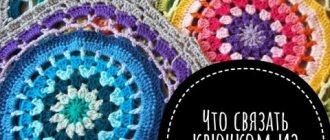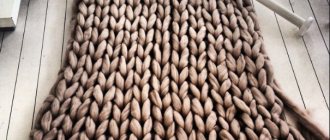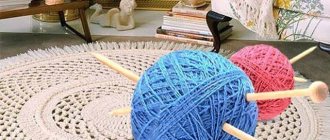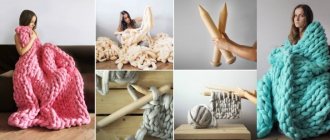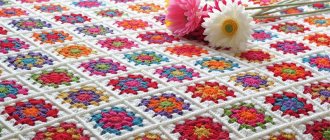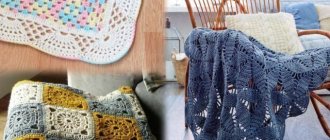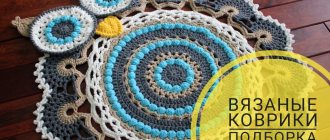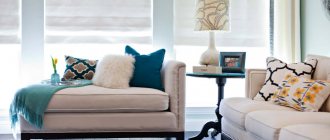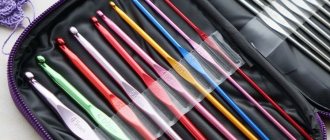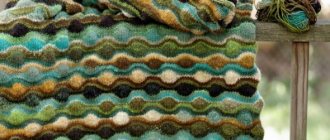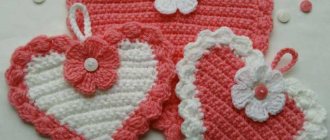Knitted blankets are in fashion now more than ever! This could be a children's blanket, on a swing, on a sofa or bed. It can be knitted with one-sided or double-sided jacquard. I have attached diagrams of the square patterns.
A gorgeous blanket that I couldn’t pass up. I haven’t knitted it yet, the photo is from the Internet for now. Squares are knitted separately, washed, steamed, and then joined (you can use a machine, you can tie them to each other, I don’t know how best yet) Approximate yarn consumption 750 g dark shade, 650 g light
In the photo with Natalya, knitted with one-sided jacquard 54 squares 17 cm x 17 cm, size 110 by 150 cm, weight 610 grams, yarn of one color is half-wool, the other is acrylic.
Jacquard pattern patterns
How to knit large items?
There is nothing difficult in knitting a children's blanket, an openwork summer blanket or a beautiful throw for the sofa. In fact, this is a fairly simple product, only in a large format. They all knit in much the same way as a wide scarf or stole - no pattern is needed.
The difference is that a large knitted product will be much heavier than a regular fabric blanket. Therefore, you should not choose “yarn eater” type blankets; they are only suitable for updating the appearance of old upholstered furniture.
Important! Consider how you will use the finished blanket - spread and fold, wash and dry. Therefore, the lower the total weight of the yarn product, the more practical the hand-made product will be.
A set of loops, if knitted, is carried out from the end - knitted across, as long as required along the length of the product. By tying the border around the perimeter, it is easy to increase the size of the product.
A blanket is crocheted, most often from squares or other geometric fragments. Then they are sewn or attached to each other as they are knitted. The overall piping around the perimeter and fringe will make the cover for a bed or sofa completely complete.
Best tool
Typically, needlewomen use one of two tools for knitting.
- Knitting needles.
- Hook.
Of course, there is needle knitting. However, this technique has not become widespread due to the great complexity of execution.
Hook
Crochet hooks come in different sizes and shapes.
Crocheting with this wonderful tool is very easy, so it is perfect for beginners. They create a variety of patterns. It is small, compact and does not take up much space.
The main disadvantage is the ribbing and rigidity of the products. The row of loops is not tight, creating a simple thing takes a lot of time.
Spokes
Knitting needles of different thicknesses and lengths
Suitable for more experienced craftswomen. Knitting with them is difficult, but when compared with crocheting, the process of creating airy patterns becomes noticeably more complicated. They allow you to knit large projects in a short time (an experienced knitter can make up to four loops per second). Things turn out soft, smooth (all loops, regardless of tension, will be equal to each other), pleasant to the skin.
There are several types of knitting needles.
- Open
Open or stocking knitting needles
Sold in sets of five. Relatively short, pointed on both sides. The main purpose is knitting in the round. Suitable for making mittens and socks.
- Closed.
Straight closed knitting needles
Sold as a pair. The longest of all knitting needles. They are convenient for knitting long, straight items, such as a scarf or sweater. Often used to create a blanket.
- Ring
Circular or ring knitting needles
They are two short sticks connected with a thin fishing line. They are universal and can replace any knitting tool. Disadvantages include:
- the need to accurately select the length of the fishing line;
- complex knitting technique.
When you decide to knit a blanket with knitting needles, use closed knitting needles. They will prevent the loops from slipping from the reverse side and allow you to create a variety of motifs. In addition, they make it easier to change yarn colors.
Devices for knitting a blanket
It is important to take into account the time required to knit large items. The thinner the thread, the smaller the number of hook or knitting needles (No. 1, No. 1.5 or No. 2), the longer it will take to knit.
Small openwork takes a long time and painstaking work. A blanket made from thick yarn is knitted quickly - in a few hours or evenings you will have a new thing.
You can make a blanket with your own hands using various handmade tools:
- Those who know how to knit only with knitting needles will need 2 knitting needles with a flexible connection (line, cambric) from 3 to 9 cm in diameter, depending on the thickness of the yarn.
- The hook is the most popular handmade item. Its thickness is indicated by numbers from 0.5 to 5. This is the loop passage in millimeters. There is also a crochet needle for Tunisian knitting, it is very dense and not suitable for a blanket. Knitting with a fork is one of the techniques that involves a hook, but it produces a very loose fabric with elongated strands, which is also not very practical for a blanket.
- You can knit a thick blanket on your arms - without knitting needles or a hook. The essence of knitting is to throw stitches from hand to hand. The end result should look like it was knitted using stockinette stitch. It is a great success to find suitable thick knitting needles for thick polyamide yarn, from which rugs and blankets are knitted.
- The fabric can be embroidered in squares or knitted on a grid. This is when colored threads are crocheted and tied in a knot, then the ends are trimmed. The ancient technique is borrowed from the artisans who make Asian rugs, but it is suitable for handmade rugs, throws and throws.
Using circular knitting needles
This type of knitting needles is used when it is necessary to obtain a seamless product or in case of insufficient length of conventional knitting needles.
Circular knitting principle:
- Cast on the number of stitches corresponding to the size of the intended blanket.
- The needle with the last stitch cast on should be in your right hand, and the first one in your left hand.
- Knit the loops together, alternating, for example, 2 knits and 2 purls, discarding excess loops that interfere with knitting onto the fishing line between the knitting needles.
- Repeat this knitting algorithm until the required size of the product is obtained.
- Close the loops.
When using circular knitting needles, it is important to consider that, as a rule, only the front side of the blanket is created in this way.
What to knit a blanket cape from
A blanket is the most practical way to organize leftover yarn of different colors. When sorting threads into a large-format product, it is important to understand what the product should turn out to be:
- Warm winter blankets and capes are knitted from natural wool and mixed yarn. Remains of bobbins and skeins with the addition of down and fluffy pile, alpaca, mohair or other warm yarn are suitable.
- A lightweight openwork product is suitable as a bedspread for the summer heat. Cotton threads, linen, viscose and synthetic silk are types of yarn that have a cooling effect.
- It is better to knit children's blankets from special yarn that does not bite. Several such options can be offered in any yarn department. The skeins differ in composition and texture. Their main property is that the child will not be capricious due to heat, cold, irritation or diaper rash.
Note! For colored products, you can combine yarn of different compositions, but they must be the same in thickness.
Patterns for children's blankets
Blue plaid
The dimensions of this cozy blanket for a baby are 60x80 cm. For it we will need:
- 250 grams of blue yarn;
- circular needles No. 3.
Scheme
White plaid
A delicate white blanket is perfect for a newborn. Its dimensions are 100×100 cm. You will need:
- 400 g of white yarn (merino wool, 225 m in 50 g);
- knitting needles No. 2.5;
- hook No. 1.5;
- white ribbon.
Scheme
Simple baby blanket
Size 70x75 cm.
- yarn - 100% acrylic (145 m per 100 g) - 350 g blue;
- knitting needles number 6.
Scheme
Delicate baby blanket
Its dimensions are 70x86 cm. For knitting you will need:
- 450 g of white yarn (55% merino wool, 33% microfiber, 12% cashmere, 125m per 50 g);
- circular knitting needles No. 3.5
Scheme
What patterns are blankets knitted in?
A blanket is a cape, bedspread, light baby blanket for a baby's stroller or crib, so it is recommended to choose double-sided patterns.
Important! Today, many knitting patterns have been developed where only knit and purl stitches are combined. Accordingly, on the wrong side they will alternate in the reverse order.
The most popular patterns for double-sided knitting patterns can be found in old magazines, books and manuals for beginning needlewomen. The most popular patterns are a hint for those who cannot decide how to knit a blanket:
- chessboard;
- network;
- herringbone;
- zigzag.
For more experienced craftswomen, beautiful double-sided crochet patterns such as “peacock feathers” are suitable. On the reverse side these are “sheaves”.
Note! Even if the pattern is chosen correctly, the reverse side should be knitted as neatly as the front side of the product.
From one-sided “squares” with knitting needles it is easy to make a light bedspread or a spectacular blanket, hemming it with a knitted lining.
Unusual handmade bedspreads are made from section-dyed yarn.
Patterns for knitting blankets - photos from old foreign magazines.
Photo with diagram of simple pattern No. 1.
Photo with a diagram of a beautiful pattern No. 2.
Photo of spectacular pattern No. 3.
Yarn and tools for work
Knitting threads can be purchased both in specialized departments of industrial stores and through numerous online stores and sites that send orders by mail. When everything has already been decided with the color and quality of the threads, you need to calculate their quantity, with a small margin.
In each specific case, the number of meters of yarn will depend on its thickness, but for weight this calculation will be approximately as follows: for a blanket measuring 80X120 cm you will need 2 kg, and for a bedspread 150X200 cm - 6 kg of yarn.
You can knit in three ways:
- crochet, it is more convenient and faster for beginners, also more suitable for openwork patterns;
- knitting needles, the diameter of which depends on the thickness of the threads;
- by hand, this requires a giant yarn and minimal skills to quickly get the result of the work.
Crochet patterns and patterns
A huge number of regular and double-sided patterns are suitable for crocheting large items. Those who have mastered how to knit stitches, half-stitches and air loops will not have any difficulty reading any crochet pattern for a blanket.
Photo of the product with diagram No. 1.
Photo of a children's blanket with pattern No. 2.
Photo with a diagram of a masterpiece with a beautiful pattern No. 3.
Square patterns
For those who find it difficult to knit a large continuous fabric, it is recommended to master the pattern for a granny square blanket. A very simple pattern using only double crochets.
“Granny square” can be knitted with threads of the same color or alternate each row with a different yarn. The result is blankets and capes of completely different designs.
In the same way, without description, but according to the square pattern, it is proposed to knit several attractive items for the interior.
Recommendations from the experts
Simple and complex designer models can serve as an example for your designer product - a warm cape, a baby blanket for a crib for the summer or an all-season blanket in a patchwork style.
Fabrics that combine smooth squares with knitting needles and openwork inserts, crocheted from the same yarn or with other color options, look impressive.
A smooth fabric can be crocheted along the edge in the form of a wide openwork border. On a knitted cloth you can embroider any pattern along the loops.
In addition to squares, 6-sided motifs and 8-sided patterns (knitted or crocheted) are used to make large products.
Helpful advice! When sewing knitted rectangles, it is advisable to alternate the direction of work so that each fragment faces the previous one.
Products using the “enterlac” technique look beautiful, when inclined squares are knitted with knitting needles.
Those who do not like to knit wide panels should learn how to knit in stripes, connecting the edges through a common knitting of edge loops.
See a selection of simple patterns for blankets in the interior design photos.
Using braids and harnesses
When creating a blanket with additional elements, you should use any of the above methods in the main knitting, and in some places adhere to a certain algorithm for creating a pattern (braids, strands).
To decorate the product “oblique”:
- Cast on the number of stitches corresponding to the size of the intended blanket pattern.
- Remove the first gearbox.
- Knit the second stitch first, then the first stitch.
- “Discard” the point of the knitting needle.
- Repeat the above steps to obtain a second thin braid, but knit the lpt not one at a time, but two at a time: first the two farthest ones, then the closest ones.
- Throw the pt onto the knitting needle.
- Repeat point 3.
- Repeat until you get the desired number of braids in the product picture.
- Complete a series of ipt.
- Close Fri.
To create “bundles” on a blanket:
- Cast on 28 stitches on needles, including 2 stitches.
- From the first to the eighth row - 2 purl loops, 2 - opposite stitches alternately throughout the entire row.
- Ninth row: purl 2 stitches, 2 opposite stitches, purl 2 stitches. Drop 8 stitches on the outside needle and leave at work. Work 6 stitches from the left needle: 2 knit stitches, 2 opposite stitches, 2 knit stitches. Return the left stitches to the knitting needle and knit: 2 purl stitches, 2 knit stitches, 2 purl stitches, 2 knit stitches. Complete the row by knitting: 2 purl sts, knit 2 sts, purl 2 sts.
- Rows 10-16: repeat step 2.
- Row 17: purl 2 stitches, knit 2 stitches, purl 2 stitches. Skip 8 sts and insert needle in next 6 sts. Remove all existing stitches from the left needle, picking up the remaining stitches to work with. Complete the row: 2pt, 2pt, 2pt, 2pt, 2pt, 2pt, 2pt, 1pt.
- Rows 18-25 repeat step 2.
- Repeat the above sequence of actions until the required size of the harness pattern on the product is obtained.
- Close the loops.
Photos of crocheted and knitted blankets
Weaving into other patterns
The simplicity of knitting a rice pattern allows you to harmoniously combine it with other patterns. Volumetric, protruding tubercles of “rice” can themselves become a decoration of a smooth canvas or be woven into other, larger patterns as details.
Rice columns on the surface
The decoration of the fabric knitted with stockinette stitch will be elements of rice knitting. These can be columns, diamonds or other shapes.
Volumetric elements can be placed as decoration on the front of the product or the item can be knitted with a completely selected pattern.
Filling geometric shapes
Knitted large geometric elements look impressive when filled with smaller details. A simple rice pattern works great for this. Framed by braids, crossed stripes and other large elements, small and convex rice looks impressive and appropriate.
Above is the knitting pattern “Filling Geometric Shapes with Rice Stitch.”
Performing decreases and increases in the figure (Fig.
It would seem that such a simple task sometimes causes difficulties for beginning knitters. As a rule, they are associated with the desire to preserve the design and at the same time change the size of the knitted fabric. And if when crocheting the issue is solved simply, then when working with knitting needles, decreases/increases must be done carefully, taking into account the specifics of the pattern.
Decreases/increases must be in pairs, otherwise the design will be lost. But there is a second problem - we get a too rapid decrease/increase. This means that we do such techniques half as often: instead of every 2nd, in every 4th r.
The proposed diagrams show how increases in the form of yarn overs are located for symmetrical expansion and for one-sided expansion. The same patterns can be used for decreases by knitting 2 stitches together.
Making a rice pattern for straight knitting
Since the knitted rice pattern is based on the pattern of a regular elastic band 1l.x1i., the number of stitches cast on must be even. Vertical repeat is equal to 4 rows.
Loops on cx. shown as they appear on the front side of the canvas. Work algorithm:
- 1r. (purl): *K1, P1* – from * to * repeat on all stitches of the row;
- 2 rub. (front side): *top l/ loops. knit purl, purl on top. – knits.* from * to * repeat on all stitches of the row;
- 3p.: * top l/loop. knit l/loop, purl on top. – purl* from * to * repeat on all stitches of the row;
- 4p.: * top l/loop. knit purl, over purl. – knits.* from * to * repeat on all stitches of the row;
- 5p.: * over l/ stl we knit l/ stl, over purl. – purl* from * to * repeat on all stitches of the row.
Next, repeat from the 2nd to the 5th rows.
How to knit a blanket for a sofa with your own hands
To knit a blanket for a chair with crochet or knitting, you do not need to be a professional knitter. Basic skills are not difficult to master, the basic techniques are quite simple, and anyone can learn how to select threads.
The choice of the degree of complexity of the products depends on the skill of the craftswoman, but the most difficult will be making a large blanket for a sofa from thick yarn.
Choice of design and color
The bedspread has a simple shape. As a rule, it is a square or rectangle. If you are just starting to knit, choose simple techniques consisting of basic techniques. This way you will gain experience and will not be disappointed with your first job.
To decide on the shade of the threads, carefully examine the interior of the room:
- if the room is small, it is better to combine the color of the blanket with the shades of furniture, curtains or carpeting;
- in large rooms it is permissible to make bright color accents, so the shade of the blanket can be red, bright blue, dark green and “break out” of the general interior context;
- To make your home look cozier and softer, knit a blanket in warm, pastel colors.
The shape of the blanket should follow the outline of the sofa or chair. Measure the length and width of the furniture for which you are knitting a blanket, add 3-5 cm so that the edges hang beautifully from the seat.
Knitted blankets are unusual: you won’t find them in every home; they can often be called masterpieces of design art.
How to choose the right knitting needles or hook
When choosing knitting needles, be sure to pick them up. They shouldn't be too heavy for you. The body of a high-quality knitting needle is smoothly polished. The ends should be rounded, but not sharp.
The “correct” tools have their own characteristics: they must be well polished and not have too pointed ends so as not to injure your hands.
The thinner your threads, the lighter in weight you choose knitting needles, for example, bone or plastic. The numbering of the knitting needles is related to the thickness of the thread. The tool should be twice as thick in diameter as the thread. A similar approach in choosing a hook.
A variety of tools and accessories to make the knitting process easier and more enjoyable.
In addition to knitting needles or a crochet hook, you will need:
- pins for fixing loops;
- row counter so as not to get lost while knitting;
- scissors.
Selection of material
Do not use old yarn to make a large blanket: the frayed surface of the yarn will give the product a sloppy appearance.
The finer the threads you choose, the more delicate the finished fabric turns out. If you plan to wash the blanket frequently, take care in advance of wear-resistant and durable knitting materials.
- Cotton thread does not electrify and allows air to pass through perfectly. It will not be hot in a blanket knitted from such threads. This is a hypoallergenic material that is suitable for children and the elderly. Cotton does not deform, which means your blanket will not lose its shape over time.
- Wool thread provides good warmth in inclement weather. A bedspread made from this thread looks impressive. But woolen material can stretch if not cared for properly, and pellets form on it. You need to wash the finished item carefully. Using special means and dry only in a horizontal position on a flat surface.
- Acrylic yarn is good for interior items due to the variety of bright, accent colors. It does not allow air to pass through well and absorbs moisture, becomes electrified and can become deformed over time. A blanket made of acrylic threads will rather serve a decorative function.
Knitting patterns for bedspreads
To knit a bedspread with your own hands, airy patterns are suitable. Fillet knitting looks especially impressive. If you are new to combining yarn shades, choose threads with ready-made sectional dyeing. Then, during the knitting process, the blanket will acquire delightful gradient transitions.
If a complete sofa cover is being created, then several individual elements are knitted, and by sewing them together it is possible to obtain a beautiful, universal product that has no analogues on the market.
Openwork bedspreads look sophisticated and elegant. To do this, choose patterns with arches and air loops.
There are various patterns for knitting and crocheting.
If you are knitting a children's blanket, make sure that the cells of the finished product are not too large. Otherwise, the baby may get confused in such a thing.
Handicrafts should be in harmony with the furniture and decoration of the room, and also correspond to the style direction.
Manufacturing process
It is better to knit a large bedspread in squares. This makes it easier to work and you will control the process of pattern formation.
- Study the drawing or diagram of the work to be done.
- Knit a sample pattern using the selected threads. Calculate whether there is enough material for the entire job. Make adjustments or change the needles to a different number.
- Cast on the required number of stitches, not counting the edge stitches (first and last).
- Knit the blanket material in order according to the pattern.
- Sew or knit all the elements together.
- Finish the edge of the finished product.
Typically, a sofa bedspread is knitted according to the shape of the furniture: a rectangle for a classic one, a circle or an oval, of four parts connected diagonally for a corner sofa.
Decoration
Decorating is a creative and exciting process. This gives the finished item a unique, inimitable and beautiful look. Here are a few options for how to quickly decorate a knitted blanket:
- Knit openwork rows or sew a beautiful braid along the edge.
- Knit or decorate the edge of the blanket with small pom-poms or tassels.
- Knit the edge in contrasting rows to create stripes of color.
Making rice for circular knitting
The number of points, as in the first case, must be even. The vertical repeat of the pattern is 4 rows.
Image cx. corresponds to the type of canvas on the front side. Work algorithm:
- 1st row: *Knit 1, purl 1* – from * to * repeat until the end of the row;
- 2p.: above the faces. We knit knit stitch, purl over. – purl* - from * to * repeat until the end of the row;
- 3p.: above the faces. we knit the stitches from the purl, over the purl. – front stitch * - from * to * repeat until the end of the row;
- 4p.: above the faces. We knit knit stitch, purl over. - purl* - from * to * repeat until the end of the r.
Next we repeat from the 1st to the 4th row. to the desired height of the product.
